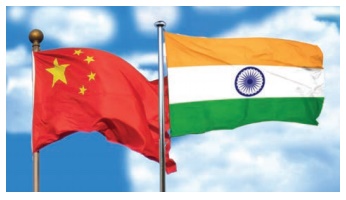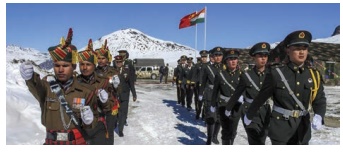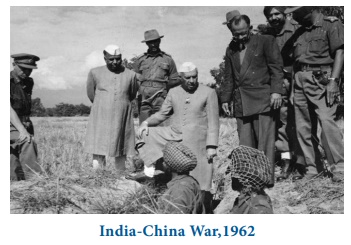Chapter: 12th Political Science : Chapter 10 : India and It’s Neighbours
India-China Relations
India-China Relations

The Modern history of India-China relations starts
after 1949, with China becoming a Communist country. India was one of the first
country to recognise the People’s Republic of China. However, the initial
relationship did not last long as India became suspicious of China’s intention
when Tibet was occupied by the Chinese army in 1950. The Hindi – Chini – Bhai
Bhai (Indians and Chinese are brothers) enthusiasm in the 1950s did cast off
some of India’s fears, but all these developments that happened in due course were
lost with the India and China war of 1962. India-China relations can be broadly
categorised into three aspects – border issue; economic interests; and
cooperation on international issues.
India and China are civilizational
powers with long and historical legacies. Buddhism went from India to China
along with texts and culture. Fa Hien and Xuan Zhang are some of the travellers
who came to ancient India to study. Add to the cultural relations, the ancient
Silk Road allowed closer economic relations.
Border Issue

India and China share over 4056 km long border. It
is divided into three sections; the border to the east of Bhutan, central
border across Utter Pradesh, Punjab and Himachal Pradesh and the border
separating Jammu and Kashmir from Chinese territories of Sinkiang and Tibet.

India – China border is known as the McMahon Line,
named after Arthur Henry McMahon who was the Secretary of State for India in
the British Cabinet. This demarcation was determined in 1914 at the Conference
of the representatives of British India, Tibet and China held at Shimla. The
boundary line was drawn taking into consideration of the natural boundary as it
passes through Tibetan Plateau in the north and Indian hills in the South. This
boundary was accepted by all the representatives, although, China at a later
date condemned it as an imperialist line. India continues to accept this line
as the border with China.

In 1949, at the end of a protracted
civil war, a communist regime was establised in China. China had always treated
Tibet as its Province and used to collect tributes from her. The Communist
regime also treated it as one of her autonomous Provinces. But, a theocratic
Tibet could not reconcile with socialist China. The Tibetan issue, particularly
granting asylum to Tibetan leader Dalai Lama and his people was a cause of rift
between these two countries.
The roots of the India-China border issue can be
traced to centuries, its immediate reason relates to China’s occupation of
Tibet in 1950. China’s reasons for occupation is based on historical linkage
and ideological fervour.
Ever since the occupation of Tibet, China started
claiming many of Indian territory as theirs. Despite the talks both the countries
had since the 1950s, there was hardly any progress in the clear demarcation of
borders. Nonetheless, there was information about frequent cross border
infiltrations. By 1961, India decided to firmly fix the borders and launched
‘forward policy’, establishing military posts in the disputed territories. This
move by India did not go well with China and it launched a massive attack on
Arunachal Pradesh and Ladakh on October 20, 1962. The war lasted only for 31
days, yet it made a long lasting humiliating impact on India.
India-China War,1962
·
When China announced that it would be occupying
Tibet, India sent a letter of protest proposing negotiations on the Tibet
issue. China was even more active in deploying troops on the Aksai Chin border.
·
In 1954, China and India concluded the Five
Principles of Peaceful Coexistence, under which, India acknowledged Chinese
rule in Tibet.
·
In July 1954, Nehru wrote a memo directing a
revision in the maps of India to show definite boundaries on all frontiers;
however, Chinese maps showed some 120,000 square kilometres of Indian territory
as Chinese. On being questioned, Zhou Enlai, the first Premier of People’s
Republic of China, responded that there were errors in the maps.
· The People’s Republic of China’s leader, Mao Zedong felt humiliated by the reception Dalai Lama obtained in India when he fled there in March 1959. Tensions increased between the two nations when Mao stated that the Lhasa rebellion in Tibet was caused by Indians.
·
China’s perception of India as a threat to its rule
of Tibet became one of the most prominent reasons for the Sino-Indian War.
·
In October 1959, India realised that it was not
ready for war after a clash between the two armies at Kongka Pass, in which
nine Indian policemen were killed, the country assumed responsibility for the
border and pulled back patrols from disputed areas.
·
On October 20, 1962, China’s People’s Liberation
Army invaded India in Ladakh, and crossed the McMahon Line in the then
North-East Frontier Agency.
·
Till the start of the war, the Indian side was
confident that war would not be started and made little preparations. India had
deployed only two divisions of troops in the region of the conflict, while the
Chinese troops had three regiments positioned.
·
In 1962, the world’s two most populous countries
went to war. The Sino-Indian War claimed about 2,000 lives and played out in
the harsh terrain of the Karakoram Mountains, some 4,270 meters (14,000 feet)
above sea level.
·
After hundreds of more deaths and an American
threat to intervene on behalf of the Indians, the two sides declared a formal
ceasefire on November 19, 1962. The Chinese announced that they would “withdraw
from their present positions to the north of the McMahon Line.”
·
Thus, the India-China War of 1962 ended and Colombo
Conference was convened by Non-Aligned activist to resolve the dispute
amicably.

Six-Nation Colombo Conference-(10 December 1962)
Pursuant to growing tension between
India and China and the war, Mrs. Sirimavo Bandaranaike convened what came to be
known as the Colombo Conference, bringing together the leaders of Burma,
Cambodia, Egypt, Ghana and Indonesia to mediate and reach a possible solution to
the conflict between the two Asian giants. India accepted the principles of the
Colombo Conference in toto while China accepted them in principle, as the basis
to start negotiation.
Even until this day, the 1962 Sino-Indian War is a
widely debated topic. The end of the war threw a new boundary line between
India and China known as Line of Actual Control (LAC). In 1993, an Agreement on
the Maintenance of Peace and Tranquility along the Line of Actual Control (LAC)
on the India-China border Areas was signed during Prime Minister Narasimha
Rao’s visit to China. The LAC continues to be a matter of irritation between
both countries.
Economic Interests
Since the mid-1980s, India and China started having
a closer bilateral economic relations. The process of dialogue initiated by the
governments of the two countries helped in identifying the common trade
interests. In 1984, India and China entered into a Trade Agreement, which
provided them with the status of Most Favoured Nation (MFN). Since 1992, India
and China have been involved in a full-fledged bilateral trade relations.
India was the 7th largest export destination for
Chinese products and the 27th largest exporter to China. India’s top exports to
China included diamonds, cotton yarn, iron ore, copper and organic chemicals.
China’s top exports to India include electrical machinery, equipment,
fertilizers, Chinese antibiotics, Chinese organic chemicals. The cumulative
Chinese investment in India till March 2017 stood at US$ 4.91 billion and the
cumulative Indian investment in China till March 2017 reached US$ 705 million.
Activity

Guided Discussion Teacher divide the
class into two groups and ask them to
refer e-paper of The Hindu (27.1.2018 – The HINDU Explainer) and Indian Express
(28.8.2018 – A Year after Doklam face-off). After reading two Articles by the
students teacher can organise the activity in the class.
1. What is the Doklam issue all about?
2. How did it come about?
3. Why does it matter?
4. Did Bhutan raise it with China?
5. When and why, did the face-off begin?
6. What were India’s concerns?
7. When did negotiations between India and China to resolve the
crisis begins?
8. What arguments did India put forth in these negotiations?
9. What led to a breakthrough?
10. Had China entered Doklam earlier?
Cooperation on International Issues
In the international arena, India and China are
competitors for resources. Investments in many of the developing countries by
both these emerging Asian giants are all to meet the increasing economic
demands of India and China. Despite the widespread competition, India and China
have also found some real convergence of interests. Both the countries support
for multipolar world order and resist interventionist foreign policy doctrines
emanating from the West, particularly the United States. In addition, China and
India also share wide-ranging concerns on climate change, trade negotiations,
energy security, and global financial crisis. India and China also play a
significant role in the WTO and global trade negotiations in the hope for
getting better leverage for the developing world over developed states.
In addition to this significant role, China and
India are also partners in major international organisations like BRICS
(Brazil, Russia, India, China and South Africa), ASEAN (Association of
Southeast Asian Nations), EAS (East Asian Summit), SCo (Shanghai Cooperation
Organisation), etc.
Related Topics